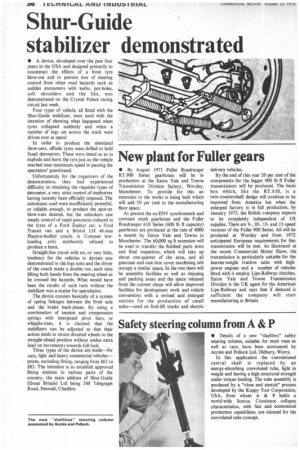Shur-Guide stabilizer demonstrated
Page 38

If you've noticed an error in this article please click here to report it so we can fix it.
• A device, developed over the past four years in the USA and designed primarily to counteract the effects of a front tyre blow-out and to prevent loss of steering control from other road hazards such as sudden encounterswith kerbs, pot-holes, soft shoulders and the like, was demonstrated on the Crystal Palace racing circuit last week.
Four types of vehicle, all fitted with the Shur-Guide stabilizer, were used with the intention of showing what happened when tyres collapsed suddenly and when a number of logs set across the track were driven over at speed In order to produce the simulated blow-outs, offside tyres were drilled to hold fused detonators. These were timed so as to explode and burst the tyre just as the vehicle reached near-maximum speed in passing the spectators' grandstand.
Unfortunately for the organizers of the demonstration, they had experienced difficulty in obtaining the requisite types of detonator, a very strict control of explosives having recently been officially imposed. The substitutes used were insufficiently powerful, or reliable enough, to produce the spot-on blow-outs desired, but the onlookers saw steady control of rapid punctures induced in the tyres of a Ford Zephyr car, a Ford Transit van and a Bristol LH 46-seat Plaxton-bodied coach. A Cornmer lowloading artic stubbornly refused to produce a burst.
Straight-line travel with no, or very little, tendency for the vehicles to deviate was demonstrated in the logs tests and the driver of the coach made a double run, each time lifting both hands from the steering wheel as he crossed the hazards. What would have been the results of such tests without the stabilizer was a matter for speculation.
The device consists basically of a system of spring linkages between the front axle and the brake back-plates. By using a combination of tension and compression springs with interposed pivot bars, or whipple-trees, it is claimed that the stabilizers can be adjusted so that their action tends to return diverted wheels to the straight-ahead position without undue extra load on movements towards full-lock.
Three types of the device are made—for cars, light and heavy commercial vehicles— prices, excluding fitting, ranging from £65 to E85. The intention is to establish approved fitting stations in various parts of the country, the main address of Shur-Guide (Great Britain) Ltd being 248 Telegraph Road, Heswall, Cheshire.






































































































